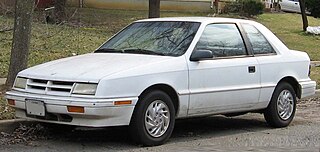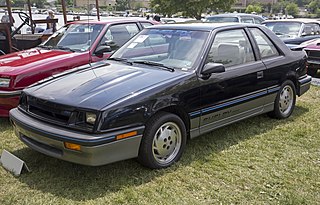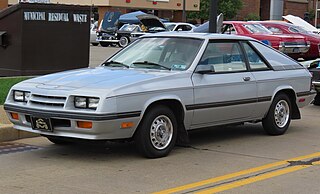Dodge is an American brand of automobiles and a division of Stellantis North America, based in Auburn Hills, Michigan. Dodge vehicles have historically included performance cars, and for much of its existence Dodge was Chrysler's mid-priced brand above Plymouth.

Muscle car is a description according to Merriam-Webster Dictionary that came to use in 1966 for "a group of American-made two-door sports coupes with powerful engines designed for high-performance driving." The Britannica Dictionary describes these as "an American-made two-door sports car with a powerful engine."

Carroll Hall Shelby was an American automotive designer, racing driver and entrepreneur. Shelby is best known for his involvement with the AC Cobra and Mustang for Ford Motor Company, which he modified during the late 1960s and early 2000s. He established Shelby American in 1962 to manufacture and market performance vehicles. His autobiography, The Carroll Shelby Story, was published in 1967.

The Dodge Daytona is an automobile which was produced by the Chrysler Corporation under their Dodge division from 1984 until 1993. It was a front-wheel drive hatchback based on the Chrysler G platform, which was derived from the Chrysler K platform. The Chrysler Laser was an upscale rebadged version of the Daytona. The Daytona was restyled for 1987, and again for 1992. It replaced the Mitsubishi Galant-based Challenger, and slotted between the Charger and the Conquest. The Daytona was replaced by the 1995 Dodge Avenger, which was built by Mitsubishi Motors. The Daytona derives its name mainly from the Dodge Charger Daytona, which itself was named after the Daytona 500 race in Daytona Beach, Florida.

The Dodge Shadow and Plymouth Sundance are economical 3-door and 5-door hatchbacks that were introduced for the 1987 model year by the Chrysler Corporation. For 1991, a 2-door convertible variant was added to the Shadow lineup; this bodystyle was not offered by Plymouth. The Sundance/Shadow replaced the Omni/Horizon models of their respective marque.

The Dodge Charger is a model of automobile marketed by Dodge in various forms over eight generations since 1966.

Pony car is an American car classification for affordable, compact, highly styled coupés or convertibles with a "sporty" or performance-oriented image. Common characteristics include rear-wheel drive, a long hood, a short decklid, a wide range of options to individualize each car and use of mass-produced parts shared with other models. The popularity of pony cars is largely due to the launch of the Ford Mustang in 1964.

The Dodge Omni and the nearly identical badge engineered variant, the Plymouth Horizon, is a subcompact car manufactured and marketed by Chrysler Corporation for model years 1978-1990. The first Chrysler model line produced with front-wheel drive, the Omni and Horizon were also the first front-wheel drive economy cars assembled in the United States. Marketed for eleven years with very few changes, around 2,500,000 Omnis and Horizons were manufactured, with the Plymouth variants more popular than the Dodge-branded models.

The Chrysler B and RB engines are a series of big-block V8 gasoline engines introduced in 1958 to replace the Chrysler FirePower engines. The B and RB engines are often referred to as "wedge" engines because they use wedge-shaped combustion chambers; this differentiates them from Chrysler's 426 Hemi big block engines that are typically referred to as "Hemi" or "426 Hemi" due to their hemispherical shaped combustion chambers. The corporation had been seeking a smaller and lighter replacement for its FirePower engines, in part because new styling dictates meant moving the engine forward in the chassis which negatively affected weight distribution.

The LA engines are a family of pushrod OHV small-block 90° V-configured gasoline engines built by Chrysler Corporation. They were factory-installed in passenger vehicles, trucks and vans, commercial vehicles, marine and industrial applications from 1964 through 2003. Their combustion chambers are wedge-shaped, rather than polyspherical, as in the predecessor A engine, or hemispherical in the Hemi. LA engines have the same 4.46 in (113 mm) bore spacing as the A engines.

The 2.2 and 2.5 are a family of inline-4 engines developed by Chrysler Corporation originally for the Chrysler K- and L-platforms cars and subsequently used in many other Chrysler vehicles. After its launch in 1981, it became the basis for all Chrysler-developed 4-cylinder engines until the Chrysler 1.8, 2.0 & 2.4 engine family was released in 1994. It was the first Chrysler engineered four cylinder engine since the Chrysler flathead four cylinder was discontinued in 1933.

The Dodge Magnum is a nameplate used by several Dodge vehicles, at different times and on various markets. The name was first applied to a large Chrysler B platform-based 2-door coupe marketed from 1978 to 1979 sold in the United States and Canada. From the 2005 to the 2008 model years, the nameplate was revived for a Charger-based station wagon on the rear-wheel drive Chrysler LX platform, produced in Canada and sold on the American and Canadian market.

The Shelby Mustang is a high-performance variant of the Ford Mustang built by Shelby American from 1965 to 1967 and by the Ford Motor Company from 1968 to 1970.

The Shelby Lancer was a limited-production hatchback sports sedan based on the Dodge Lancer. Modified by Carroll Shelby for 1987 and in Graphic Red only, the Shelby Lancer was intended to be an American counterpart to such European sedans as the BMW 3 Series and Peugeot 405. It was well equipped inside with many amenities not offered on the normal Lancer, including a special 10-speaker Pioneer CD audio system, one of the first Compact Disc systems offered in an American car. There were only 800 of these cars made in total; 400 came with a 3-speed Automatic transmission (A413) and leather interior, and 400 with a 5-speed Manual transmission (A520) and cloth interior. Other Shelby-branded items included a numbered plaque attached to the dashboard along with Shelby 15 inch wheels, a Shelby steering wheel, and a Shelby valve cover. The various VIN plates and build labels on the car all indicated "Shelby Automobiles" instead of the typical Chrysler or Dodge labels found on normal production vehicles.

The Shelby CSX was a limited-production high performance automobile based on the turbocharged intercooled Dodge Shadow and Plymouth Sundance. These cars were offered by Shelby Automobiles Inc. from 1987 through 1989. The CSX serial number was established by AC Cars, in Surrey, England. The purpose of that serial number was to identify which chassis were to be exported to Shelby in the U.S. CSX stood for "Carroll Shelby Export".

TorqueFlite is the trademarked name of Chrysler Corporation's automatic transmissions, starting with the three-speed unit introduced late in the 1956 model year as a successor to Chrysler's two-speed PowerFlite. In the 1990s, the TorqueFlite name was dropped in favor of alphanumeric designations, although the latest Chrysler eight-speed automatic transmission has revived the name.

The Dodge Charger (L-body) is a subcompact two-door hatchback/fastback built by Dodge from 1981 until 1987. It is based on Chrysler's front-wheel drive L platform. A companion model, the Plymouth Turismo, was also marketed.

Shelby American, Inc. is an American high performance automobile company founded by driver Carroll Shelby. The Shelby American name has been used by several legally distinct corporations founded by Shelby since his original shop in Venice, California began operation in 1962. The current iteration is a wholly owned subsidiary of Carroll Shelby International, Inc., a holding company formed in 2003. Carroll Shelby International's other wholly owned subsidiary is Carroll Shelby Licensing, which licenses the name and trademarks associated with Shelby to other companies. Shelby American was the first automobile manufacturer in the state of Nevada. Shelby American manufactures component automobiles, including replicas of the small-block and large-block AC Cobras, the Shelby GT350 and the GT500 Super Snake. Since 2005, Shelby American has released new models each year.
Callaway Cars Inc. is an American specialty vehicle manufacturer and engineering company that designs, develops, and manufactures high-performance product packages for cars, pickup trucks, and SUVs. They specialize in Corvettes and GM vehicles. New GM vehicles are delivered to Callaway facilities where these special packages and components are installed. Then the vehicles are delivered to GM new car dealers where they are sold to retail customers, branded as Callaway. Callaway Cars is one of four core Callaway companies, including Callaway Engineering, Callaway Carbon and Callaway Competition.




















